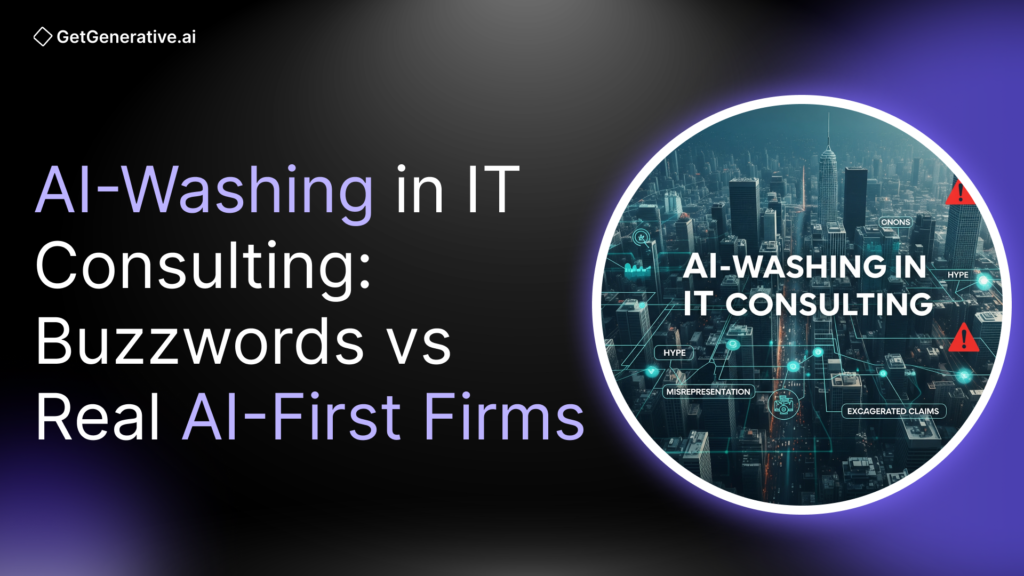AI-Washing in IT Consulting: Buzzwords vs Real AI-First Firms
From Outsourcing to “Digital Transformation” – History Repeats
In the mid-2000s, the IT industry witnessed a significant shift. Traditional outsourcing firms began rebranding themselves as digital transformation specialists. However, beneath this new label, many continued with the same delivery models and talent pools. The term “digital transformation” has become a catch-all buzzword, often signifying superficial changes, such as migration to the cloud or updating legacy applications, without any fundamental shift in methodology or approach.
Fast forward to today, and a similar pattern emerges. The buzzword has changed to “AI-first,” but the underlying strategy remains the same. Consulting firms worldwide are now proclaiming themselves as AI-driven organizations. Yet, in many cases, this is more about branding than substance—a phenomenon aptly termed “AI-washing.”
Understanding AI-Washing in Consulting
AI-washing refers to the practice of overstating or fabricating a company’s AI capabilities to capitalize on the current hype surrounding artificial intelligence. It’s like greenwashing in sustainability, where companies exaggerate their environmental efforts. In IT consulting, AI-washing occurs when firms claim to offer AI-powered solutions without the necessary infrastructure, expertise, or genuine integration of AI technologies.
A study highlighted that 40% of “AI startups” in Europe had little to no actual AI in their products. This trend is mirrored in IT consulting, where firms boast about their AI capabilities, but upon closer inspection, the offerings are often superficial.
The Hallmarks of AI-Washing
Several indicators can help identify AI-washing in consulting:
- Buzzword Overload: Proposals and pitches are filled with AI-related jargon—terms like “intelligent,” “cognitive,” “AI-driven,” and “machine learning”—without concrete explanations or demonstrations of how these technologies are applied.
- Generic Solutions: Firms offer one-size-fits-all AI solutions that are not tailored to the client’s specific needs or data.
- Lack of Case Studies: When pressed for examples of successful AI implementations, these firms struggle to provide tangible results or measurable outcomes.
- Minimal AI Talent: The teams deployed for projects consist mainly of traditional roles, with perhaps one or two individuals labeled as AI experts, indicating a lack of depth in AI expertise.
- Flashy Demos: Sales processes often include impressive AI demonstrations that aren’t directly tied to the client’s use case, suggesting a focus on theatrics over substance.
- Evasive on Data Privacy: When questioned about data handling, privacy, and AI ethics, these firms provide vague or unsatisfactory answers, highlighting a lack of preparedness to address critical concerns.
What Truly Defines an AI-First Company?
To truly be AI-first, a company must undergo profound changes in three core areas:
- Process: The delivery process should be reinvented to integrate AI at every stage. This includes automating manual tasks, leveraging AI for data analysis, and redesigning workflows to be intelligence-driven.
- People: The workforce must be upskilled to include data scientists, machine learning engineers, and AI specialists. Training programs should be implemented to ensure AI literacy across all levels of the organization.
- Technology: The adoption of AI-native tools and platforms is crucial. This means moving beyond legacy systems and investing in technologies designed with AI and automation at their core.
Also Read – The Innovator’s Dilemma for GSIs: How AI Pods Are Disrupting IT Service Models
The Risks of Falling for AI-Washing
Engaging with firms that practice AI-washing can lead to:
- Overpayment: Clients may pay premium prices for AI solutions that don’t deliver the promised value.
- Wasted Time: Projects may take longer to complete due to the reliance on traditional methods, often disguised as AI-driven processes.
- Eroded Trust: Repeated disappointments can lead to skepticism about AI’s potential, hindering genuine innovation and adoption.
How to Spot and Avoid AI-Washing
To protect your organization:
- Ask Specific Questions: Inquire about the exact AI technologies used, how they’re integrated into the process, and request demonstrations using your data.
- Request Case Studies: Seek evidence of past successes, including metrics that showcase the impact of AI on similar projects.
- Evaluate the Team: Ensure the team assigned to your project includes qualified AI professionals with relevant experience.
- Discuss Data Handling: Engage in detailed conversations about data privacy, security measures, and compliance with relevant regulations.
Conclusion
The allure of AI is undeniable, promising efficiency, innovation, and competitive advantage. However, it’s essential to approach AI claims with a critical eye.
By understanding the signs of AI-washing and demanding transparency and proof, organizations can make informed decisions, ensuring that their investments in AI lead to genuine transformation, not disillusionment.



